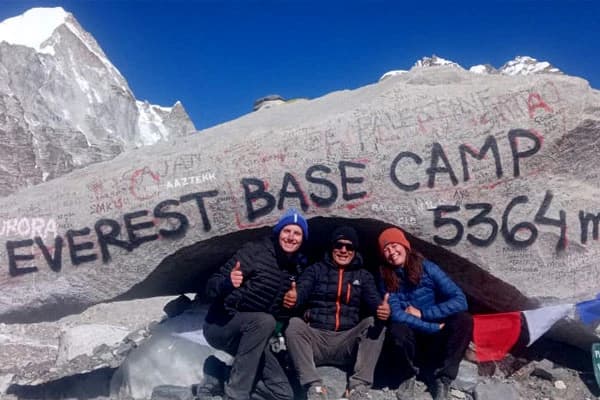What makes any trek challenging in the first place?
Well, any trekking adventure is not like a child's play as many factors affect your overall experience. The first consideration is the trekking duration and distance. Some treks may require long days of hiking while covering a long distance in a day, which can be challenging to many without prior preparations and fitness.
Similarly, theterrain conditions can be physically demanding as rugged, rocky, and steep trails put extra strain on your body.
And you know what? The weather can be unpredictable, and when you are least expecting it, it can add an extra challenge to your journey. Rainfall, snow, humidity, and reduced temperatures can test your endurance and preparedness.
One question always remains on everybody's mind, and that is altitude sickness. Starting a Himalayan trek results in a reduced oxygen supply, which increases the probability of altitude sickness. So, high altitudes can create health issues if not addressed properly.
Lastly, an unprepared mentality will transform your dream trekking experience into an unpleasant horror movie. So, without a positive mindset, your trekking experience will be challenging.
Factors Affecting the Annapurna Base Camp Trek Difficulty
Multiple elements impact the difficulty rating for the Annapurna Sanctuary Trek, even though it is not categorized as a demanding trek in Nepal. Understanding ABC Trek's difficulty factors will help you make preparations that create safer and smoother travel conditions.
These are the major elements that influence difficulty during the Annapurna Base Camp Trek, and this blog simply breaks down the challenges based on age, beginners, transportation, terrain, weather, distance, and accessibility.
Distance
The Annapurna Base Camp journey extends from 110 to 120 kilometers (68 to 76 miles) across its entire distance. People experiencing their first trekking expedition will probably have problems meeting the required time goals for the long-distance trek.

Walking distances during this trek remain within the range of 10 to 15 kilometers, which proves easier than the other mountain treks, including the Upper Mustang Trek, Kanchenjunga Circuit Trek, and Manaslu Circuit Trek.
Duration
Most ABC trek tours last 7 to 12 days while allowing enough time for acclimatizing as well as the pace of your walking. You have to walk 6-7 hours each day. The length of this moderate journey suits individuals who need an experience that lasts shorter than the Annapurna Circuit but longer than a short visit. The regular base camp itinerary provides time for proper adjustment and steady advances until reaching the base camp.
Most trekking agencies allow customers to personalize their Annapurna Base Camp Trek plans according to individual schedules and walking speeds. Selecting the Short Annapurna Base Camp Trek will offer you a brief travel experience.
Terrains
During the Annapurna Base Camp Trek, you encounter numerous changing environments that simultaneously enhance visual beauty while increasing the difficulty of your journey. Your journey will include walking on stone steps through traditional villages like Ulleri and Chomrong before entering areas featuring forest trails and eventually ascending to rocky terrain with uneven paths.

The route features suspension bridges for river crossings, while its steep inclines and declines lead to muscle strain in your legs.
Weather and Temperature Conditions
During the Annapurna Base Camp Trekking trail, weather conditions strongly affect how challenging the experience will become. Both spring (March- May), which brings 10-20°C temperatures, and autumn (Sept- Nov), with 5-15°C temperatures, produce stable conditions and unobstructed mountain vistas. Moderate temperatures create perfect conditions for long days of walking without feeling sweaty.

Winter months (Dec- Feb) present challenging weather conditions that include intense cold temperatures ranging from -5 to 10°C alongside heavy snow paths, which increase trekking difficulty in higher areas. The monsoon period from June to August brings 15-25°C temperatures and regular rain that creates slippery trails that may be blocked due to landslides. The trek to ABC can be undertaken at any time, but the most suitable seasons for comfort are springtime and autumn because of their manageable climate conditions.
Altitude Sickness
Areas that exceed 3000 meters in height require watching out for Acute Mountain Sickness (also known as altitude sickness). The Annapurna Base Camp Trek attains its highest elevation at Base Camp elevation 4130 meters where conditions create a high probability of experiencing altitude sickness. The elevation at Annapurna Base Camp may be less than Everest Base Camp, but your body requires an adjustment period anyway. Watch for mild symptoms, including headaches, nausea, and dizziness, that may arise from your trek. Not treating these symptoms properly could result in serious altitude sickness.
Acclimatization
Let's talk about one of the most important factors for a successful ABC Trekking, which is acclimatization. Since you will be reaching 4130 meters in a few days, your body needs to adapt to the changing elevation as the air starts to thin and temperatures drop in higher elevations. A failure to adapt properly to new environmental conditions will result in various health problems as well as altitude sickness. So, be mindful to listen to your body!
Is the Annapurna Base Camp Trek challenging?
Trekking to Annapurna Base Camp is a moderately challenging activity in Nepal. People at every experience level, including those from every age group, have successfully finished this journey. It is not as difficult as challenging treks like Kanchenjunga Base Camp Trek and not too easy treks like the Poon Hill Trek.
The trails are well managed, with plenty of teahouses for lodging and socializing with fellow trekkers. Walking 6 to 7 hours becomes manageable despite steep paths and stone stairs by maintaining a steady walking pace while taking enough rest stops.

Many Annapurna Base Camp packages include altitude sickness prevention methods through planned elevation increases between 300 and 500 meters to let your body adjust to changing elevation levels.
Through correct preparations and proper planning, the trek offered at Annapurna Base Camp in Nepal becomes less difficult to overcome.
Is the ABC trek safe to do?
The ABC trek is a safe journey because it is less dangerous than other routes in the Himalayas. Along the trail, you can discover well-maintained routes that lead to villages offering cozy tea houses for rest and meals. The trek contains enough cell network connectivity to connect with others, while other trekkers and guides are nearby if you require assistance. Emergency evacuation is accessible in larger villages. The lower 4,130-meter altitude compared to Everest Base Camp makes serious altitude sickness less likely to occur.
You should select a licensed guide for security and convenience because they will provide smooth navigation while also helping in emergencies. Proper preparation makes the Annapurna Base Camp trek a safe journey to undertake.
Is the Annapurna Base Camp Trek appropriate for all ages?
Every age group can access the Annapurna Sanctuary Trek because its safety features include carefully maintained paths and convenient tea-house accommodations. Yes, you heard it right, as this trek is appropriate for everyone from children to seniors. However, they must have proper preparations and good physical fitness. Usually, a longer Annapurna Base Camp Trekking itinerary provides the best conditions to adapt to altitude changes by allowing enough rest before reaching base camp.
Here is a pro tip: Hiring a licensed private guide can ensure that you can safely complete the Trek to Annapurna Base Camp, as he can assist you in emergencies while maintaining a slower pace that fits you.
Is ABC trekking beginner-friendly?
Annapurna Base Camp offers one of the best Himalayan journeys that any beginner trekker can attempt. Trekking paths throughout the entirety of the route connect you to traditional villages where you will discover numerous quaint tea houses offering necessary supplies. The trail at 4130 meters presents a manageable challenge as it remains lower than more extreme routes. The trek to ABC requires only basic hiking without any complex technical climbing elements. Many trekking agencies provide customizable Annapurna Base Camp itineraries to fit your pace and experience level. First-timers who have average fitness levels normally finish the trek successfully when they select a professional guide.
Can I do this trek to Annapurna Base Camp solo?
By doing proper research and preparation, you will execute a successful Annapurna Base Camp trek as a solo traveler. Proper management exists throughout the trails, and multiple teahouses serve the path. The trails receive proper management, and multiple teahouses operate throughout the path. When the Annapurna Region trek attracts many visitors during peak seasons, you will encounter numerous fellow trekking companions. Trekking solo enables you to enjoy some “ME TIME” and maintain flexibility throughout the journey.
However, travelling solo means you are on your own during emergencies in remote areas. Without an experienced local guide, you will lose the important cultural and natural understanding they share, so you cannot fully appreciate the great experience that becomes possible through their knowledge. If you are an expert and have plenty of solo experiences, you can go for it. However, you need to join local trekking agencies that offer both licensed guides and logistics support if you are a beginner trekker.
Is the Annapurna Base Camp trek possible without a guide?
You can travel to Annapurna Base Camp alone if you secure your necessary permits. However, going with a local guide will significantly enhance your experience throughout the Annapurna Base Camp trail. Through their knowledge, guides provide interesting information about cultural and natural aspects while helping you communicate with village locals throughout the trail. The guides assist with difficult tasks like finding suitable accommodations, even when tea houses are full, and provide assistance in case challenges occur. Professional guides help maintain your safety because of their experience working in mountainous terrain, especially when unexpected weather conditions or altitude sickness arise. People who choose to hire a guide simultaneously contribute to the local economy, which depends on tourism activities. Overall, a guide brings value to your trek experience by providing security as well as cultural insights, which create a more pleasant journey.
Best time for the Annapurna Base Camp Trekking
March to May during spring and September to November in the autumn serve as the optimal seasons to complete the Annapurna Sanctuary Trek due to mild weather and stunning views of the mountains. New buds of rhododendrons transform the landscape into colorful arrangements and allow pleasant weather conditions throughout spring. The autumn season offers perfect weather conditions to experience stunning mountain views because of its clear skies.
From December to February, winter conditions include freezing temperatures between -5 to 10°C and sometimes the building of snow barriers across the trail. The June-August monsoon period brings dangerous trail conditions because heavy rain leads to wet and slippery paths alongside leeches. However, if you want to take on the challenge, with proper preparations, you can do the ABC Trek in winter and monsoon too.
Overall, Spring and autumn provide the optimal conditions with clear weather and pleasant temperatures, making them the ideal periods for trekking in ABC.
What are the preparations required for the ABC trek?
Your success in undertaking the Annapurna Base Camp Trek in Nepal requires thorough planning before traveling to guarantee both safety and comfort.
Physical Strengthing
Your body is your ultimate companion during the ABC Trekking journey. Begin your trek preparation training between two and three months before your scheduled departure. Your stamina will improve through regular three to four walks or jogging and cycling sessions each week. The trail contains many stairs, so stair training as a regular exercise helps you develop the necessary strength. During weekends, carry a loaded backpack while hiking to familiarize yourself with trekking environments. The squats and planks exercises will enhance your leg strength and core muscle power, which makes the trekking experience more comfortable. Your initial training sessions will assist you in handling the 5-7 hour walking periods throughout your trekking adventure.
Positive Mindset
The mental components match equally with the physical requirements when trekking. Positive thinking helps you overcome obstacles that include challenging slopes and adverse weather conditions. The breathing technique will help you remain collected during pressure-filled situations. The minimal tea house amenities should be seen as an integral part of the challenging journey. Even though some days present obstacles, you will find that the incredible panorama and fulfillment from your accomplishments justify everything.
Balanced diet consideration
A well-balanced diet is the ultimate fuel for your body while trekking to Annapurna Base Camp. Your body needs rich protein, carbohydrates, and vitamins to endure a long day of walking. Your daily water consumption should reach 3-4 liters to eliminate the risk of altitude sickness. Opt for freshly cooked local food made with local vegetables to prevent any stomach issues.
Choosing a trustable local company
Selecting the right trekking company can make or break your Annapurna Base Camp Trek in Nepal. So you must carefully select the one with proper licensing. Look for reviews of past clients and thoroughly read the package details, including cost, time, safety protocols, and other services to avoid any unexpected hidden costs. Make sure that the company provides you with a licensed and expert guide for the journey. And hey, if you have any questions, always contact the company for answers, do not hesitate!
Tips to Overcome Challenges
- You should maintain a controlled and relaxed walking pace instead of hurrying to let your body acclimate better while preserving energy for the day.
- Your backpack should only contain necessary items (durable layers along with rain protection and dependable footwear) to stay lightweight.
- The first step of your meals should be garlic soup as an altitude remedy, followed by carb-heavy choices such as dal bhat for energy. Snack on nuts and chocolate.
- Keep drinking water throughout the day regardless of any feelings of thirst. Electrolyte tablets help protect against both fatigue and headaches.
- The mountain weather transforms so quickly that you need clothing that can be layered on and off according to the heat.
- Put your trekking shoes on several weeks before the hike to break them in and prevent painful blisters from developing.
- Fresh mornings allow better weather conditions while offering longer rest time at tea houses during your journey.
- Team up with a trusted trekking agency that provides you with guide/porter services.
Conclusion
Annapurna Base Camp Trek is among the most famous and moderate difficulty level treks in Nepal. From exploring the diverse natural features of the Annapurna Region to spending an amazing night at the base of the tenth-tallest mountain in the world, the ABC Trekking is a must-do for 2025 and 2026. More than 35000 nature enthusiasts from all around the world visit the Annapurna Sanctuary to experience stunning mountain vistas, forests, rivers, mountain streams, waterfalls, and alpine meadows. Despite the challenges along the route, it provides an unforgettable memory to cherish for life.
Destination Himalaya Trek and Expedition has continued serving trekkers for over twenty years from its establishment as a government-approved agency, which also belongs to TAAN (Trekking Agency Association of Nepal) and NMA (Nepal Mountaineering Association). You can depend on our services to guarantee success during your Annapurna Base Camp Trek. We provide diverse packages such as Annapurna Base Camp Trek (5 days), Annapurna Base Camp Trek (7 days), Annapurna Base Camp Trek via Poon Hill and Mardi Himal Trail,Nar Phu Valley Trek to match all preferences and timeframes, or budgets. Contact our team right now if you want to plan your Annapurna Base Camp Trek in Nepal.








